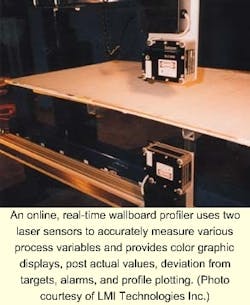Laser sensing benefits wallboard production
Joe Miller
A noncontact gallium aluminum arsenide laser sensing system based on laser triangulation technology is providing wallboard manufacturers with online, real-time wallboard thickness profiles necessary to reduce waste and improve the quality of final wallboard products. Since its introduction more than 15 years ago, the profiling system has evolved into second- and third-generation designs that are faster, more efficient, and less expensive.
During the mid-1980s, LMI Technologies Inc. (formerly LMI Selcom; Southfield, MI) helped Qualimatrix (Emeryville, CA), a machine manufacturer of equipment for online wallboard, develop its first wallboard caliper profiling system to provide Georgia Pacific Corp. (Atlanta, GA), a wallboard manufacturer and supplier, with an accurate online measurement and graphic display of wallboard thickness profiles and other related information (see figure).
To create the original wallboard caliper profiling system, Qualimatrix selected two LMI Selcom single-point industrial laser-measuring sensors to meet its need for a long-range, high-resolution sensor with a fast digital response and the ability to survive in a process environment. Using two of LMI Selcom's standard sensors (one that measures from the bottom and the other from the top), Qualimatrix's profiling systems provide caliper and width measurements that allow improved control over the wallboard production process. Thickness profile information allows the operator to make real-time adjustments and gives closed-loop control for the wet end process. The system can measure and display board width and wet weight if a scale is installed, and also is capable of measuring various process variables, providing color graphic displays, posting actual values, deviation from targets, alarms, and profile plotting. Each type of wallboard has customized quality and display parameters set up for instant access.
Laser triangulation
In 1995, Qualimatrix received an order from National Gypsum Co. (Charlotte, NC), a manufacturer and supplier of building and construction products, for several wallboard-thickness profiling systems to automate caliper profiling and data collection within its plants. After research and evaluation of laser triangulation vs. ultrasonic sensing, a team of National Gypsum engineers opted to use laser triangulation.
Laser triangulation combines a semiconductor laser with optics to project a laser spot onto a target surface. When the light hits the surface, it scatters in all directions. The sensor then collects part or all of this scattered light and focuses the image of the light spot onto the position-sensitive detector, which provides two separate current outputs. As the relative distance between the sensor and measured surface changes, the position of the image on the detector changes proportionallymaking it possible to measure the location of the measured surface accurately and consistently. Noncontact sensing proves ideal for a variety of difficult in-process checks and off-line profiling, especially when recording measurements where nondestructive operation is vital.
Qualimatrix decided to re-engineer its entire caliper profiling process to include sensors based on laser triangulation. Nineteen of these systems were shipped to the wallboard industry in 1995, and today continue to help control thickness caliper, width, taper, high centers, high shoulders, and other surface anomalies in the manufacturing process. Customers have reported significant reductions in quality claims and an improvement in market share.
System description
Qualimatrix's next-generation system consists of a compact O-frame that is installed in the live roll section before the knife. As the O-frame straddles the process line, laser distance sensors traverse across, above, and below the board taking hundreds of measurements over every inch of travel. The distance between the laser probes and the top and bottom surfaces of the wallboard are calculated and converted into caliper values when subtracted from the calibrated distance between the laser probes.
The new system displays results from the laser probe scan, providing an easy-to-analyze view of thickness data. The main graph shows a complete scan, from edge to edge, in real time as the probes move.
Next-generation sensors
Using laser triangulation, the next-generation profiling system has a totally integrated sensor within the head and a built-in processor for data averaging and filtering that virtually allows off-the-shelf installation, except for output programming or changing the format. The system provides data in both analog and digital outputs.
Characteristics of the new sensors include high-speed resolution within an accuracy of ±0.2% of the measurement range, a data-sampling rate of 16 kHz, a bandwidth (response) of 2 kHz, and a stand-off distance of up to 300 mm. A dynamic laser feedback loop allows accurate measurement without regard to color, ambient light changes, variations in object reflectivity speed, temperature of material, or general plant environmental conditions. The feedback loop allows the sensor to make virtually error-free measurements with high reliability and repeatability up to 16,000 times per second within a defined spot, while consuming little power.
The profiling system has measurement ranges of 1/4 to 8 in. (6 to 200 mm) and can operate at temperatures from 0°C to 50°C. Dimensions of the unit are 105 x 135 x 51 mm, and its weight is 1.0 kg.
As with most industrial tools incorporating optoelectronics, protection from the surrounding environment is essential. The sensor is enclosed in an airtight aluminum housing to protect it from moisture and dust. An air purge provision can be provided for cleaning and cooling the sensor optics, as well as a heat protection enclosure for operating in high-temperature, online applications. Precautions such as these are what make laser triangulation not only an accurate technique for wallboard thickness, but a reliable one as well.
JOE MILLER is a sales engineer at LMI Technologies Inc., 21666 Melrose Ave., Southfield, MI 48075; e-mail: [email protected].

